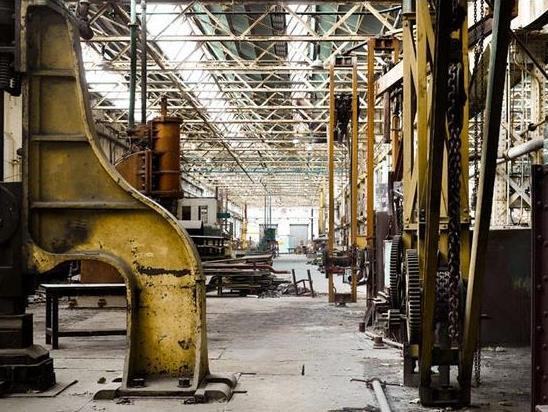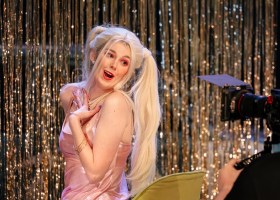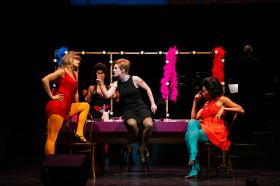Photo by Christian Fletcher
A one-woman monologue, celebrating the area of Wongan Hills in the Wheatbelt, premieres at Fringe World’s festival hub on the outer fringe of Perth, ‘Midlandia’.
Midland Railway Workshops was once a bustling collection of buildings where things were made as they were needed in Western Australia, things that wouldn’t be brought across the Nullabor or over the oceans from Europe – train wheels, large equipment parts and the like. The disused buildings are being restored, and Pippa Bainbridge expands their function again in her theatrical piece, The Silo.
The plot of The Silo is simple: a farmer’s daughter goes missing, and, after the search has been called off, her body is found in the one place that wasn’t considered – the eponymous wheat silo. The monologue is delivered from the point of view of another child in the town, recalling events and describing scenery, legends, characters, weather patterns, dietary habits and economic cycles along with the tale. The performer moves from place to place, clambering over the equipment in that corner of the shed, and posing before a curved section of weathered corrugated iron, using sound and lighting to break up the flow of words and to create links between sets of thoughts and word pictures.
Bainbridge has created a dense text, word-heavy and dripping with imagery. This may work well on the page, but does not successfully translate to live performance. The sheer number of words lead to errors in delivery and the loss of rhythm and momentum that might otherwise set a compelling pace. Content-wise, the long descriptions of landscape and weather are presented without explanatory context – while this may be a nostalgic paean to the decaying wheatbelt, it is redundant for those familiar with the area and devoid of information for those unfamiliar with it.
I am led to question a number of the play’s elements. The publicity material promises the ‘Australian Gothic,’ and while drought, wheat and sheep are undeniably ‘Australian,’ the ‘Gothic’ alone seems represented by recounting ways to die in rural childhood. The repeated descriptions of personal and communal grief are dull, and the final twist in the surprise ending closes with a revelation of childish stupidity, rather than the tragedy of the Gothic genre.
Other promised themes include indigenous dispossession. However, merely mentioning local dreaming stories does not address dispossession by settler culture, nor does it imply revenge by Noongar ancestors. The story of Wagyl is well-known in South Western Australia, yet does not necessarily relate to children drowning in mud or rising water tables and the rural curse of salinity.
The rich, if rather repetitive, description of landscape is matched by disconcertingly poor character development, with the most detail going to the town’s self-important mayor. The use of his insincere speech of condolence as a recurring motif of solidarity is baffling in its pointlessness, and the clichéd cartoons of more central characters do nothing to awaken empathy or even interest in the audience.
Theatre is more than just words, and it could be that Bainbridge is strategic in her lack of facial expression, reflecting the drab nothingness of the surrounding countryside. But it is not an engaging countenance. Her lack of energy is draining to watch, and while this may be a good indication of long-term drought conditions, it is hardly entertainment and leads to suspicions that presentation of the script has not been fully rehearsed. The words themselves are delivered in an interesting, refined inner-city accent, with occasional words such as ‘river’ and ‘water’ coming out with a jolt of strine. When rural accents are attempted, speaking in the voices of various characters, it is poorly done and unconvincing.
There are some lovely moments with the lighting. The design of set and light allow a delicate play of moods to form and tightly controlled changes echo the otherwise monotonous monologue. The lighting is so well done that it is clear that photographs should be taken of the performer in situ – it may be best to do this between or after shows, risking unnatural posing rather than introducing the noise of a large camera to the small audience space during a quiet performance.
Time-keeping for the show is also impressive. After a late start – which is rarely a good start – Bainbridge finishes to time, without giving any sense of rushing her way through the script.
The Silo holds much potential as a concept, but very little has been delivered. This is even more surprising since it was first developed and presented by La Mama as part of the Explorations Season in 2009. There is no significant development evident in this performance.
Rating: 1 star out of 5
The Silo
Presented by Aeso Studio
Performed by Pippa Deanne Bainbridge
Midland Railway Workshops, Midland, Western Australia
Fringe World
30 January – 2 February






